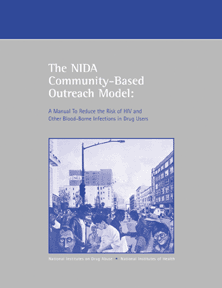Drug abuse service providers in the field now have a new tool to help them reduce the spread of drug-related disease among drug abusers. The NIDA Community-Based Outreach Model: A Manual To Reduce the Risk of HIV and Other Blood-Borne Infections Among Drug Users is designed to help community planners, policymakers, program developers, and service providers develop outreach programs to prevent the spread of infectious diseases associated with drug use - primarily HIV/AIDS, hepatitis B (HBV), and hepatitis C (HCV).
The manual is based on more than 15 years of NIDA-supported research in nationwide HIV prevention projects. The Outreach Model, tested in 52 U.S. communities with more than 60,000 injection drug users, 14,000 crack users, and many of their sexual partners, has been found effective with drug-using populations regardless of race, ethnicity, gender, and HIV status.
In more than 30 studies using community-based outreach, a significant proportion of participating drug users:
- entered drug treatment;
- stopped or reduced their frequency of injection; reuse of needles, syringes, other injection equipment; and use of crack cocaine;
- increased condom use and reduced the frequency of unprotected sex;
- obtained HIV testing with counseling before and after the tests; and
- averted HIV infection.
Published last fall, the manual guides outreach workers step by step on how to select outreach sites where drugs are purchased and used, engage drug users, and educate and counsel drug users about reducing their drug- and sex-related risks for infection. The community-based approach typically relies on outreach workers who are indigenous to the community and thus uniquely able to serve as role models, educators, and advocates for drug users.
The outreach manual helps community workers choose an appropriate "base" site, such as a converted recreational vehicle or mobile home; contact drug users where they congregate; open conversations with individuals at risk for infection; and enlist those individuals to attend counseling and education sessions in connection with HIV testing. Additional program services are recommended, such as couples or group counseling and sexually transmitted disease screening, diagnosis, and treatment and HIV treatment. Alternatively, it is recommended that outreach workers provide referrals for those services.
The manual recommends that drug users recruited to attend the 20- to 30-minute education and counseling sessions be provided accurate and up-to-date information on risky behaviors, concrete strategies and behavioral skills for reducing drug-using and sexual risks, and reinforcement for behavior change. A set of 24 cue cards guides counselors and drug users through the sessions, leading logically from "What is HIV/AIDS? HBV? HCV?" to how the infections are transmitted and how drug users can reduce their risk.
The education sessions give clear, detailed instructions for reducing the risks related to drug use and sexual activity, and they promote addiction treatment as the best method of disease prevention. The NIDA Community Outreach Model recommends HIV, HBV, and HCV testing, followed by appropriate counseling on positive or negative results.

